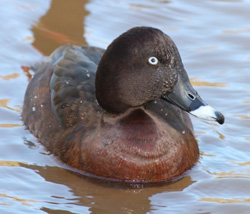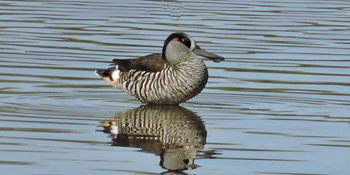Tom Parkinson's monthly column, introducing the diverse range of flora and fauna on show at Sanctuary Lakes.
The early El Niño drought conditions are already starting to have their effect on the water bird life in Sanctuary Lakes, Skeleton Creek and the surrounding wetlands. Most water birds are nomadic and are capable of flying long distances in search of a good food supply and suitable water. With the northern swamps and wetlands starting to dry, some water birds flying south have found the conditions here at Sanctuary Lakes ideal for their needs. I have chosen two who are easily recognisable: one Aythya Australis, common name Hardhead or White Eyed Duck, who have been flocking here since late September and the Pink Eared or Zebra Duck who normally arrive here in early New Year but pairs have already been seen on the Lake.
 Male White Eyed Duck with the unmistakable blue rimmed beak The White Eyed or Hardhead Duck is medium-sized, appears when in the water mainly chocolate brown with an unmistakeable white tail. In flight, the underwings are white, edged with brown. A bright white underside breast patch stands out when seen standing in the shallows. The bill has an unusual pale blue stripe on the tip. Males have a distinct white eye, while the eye is brown in females. It is the only true diving duck in Australia. They sit low on the water and feed by diving deeply, often staying submerged for as long as a minute at a time. They slip under the water with barely a ripple, simply lowering their heads and thrusting with their powerful webbed feet. They eat a broad range of small aquatic creatures, and supplement this with water weeds.
Male White Eyed Duck with the unmistakable blue rimmed beak The White Eyed or Hardhead Duck is medium-sized, appears when in the water mainly chocolate brown with an unmistakeable white tail. In flight, the underwings are white, edged with brown. A bright white underside breast patch stands out when seen standing in the shallows. The bill has an unusual pale blue stripe on the tip. Males have a distinct white eye, while the eye is brown in females. It is the only true diving duck in Australia. They sit low on the water and feed by diving deeply, often staying submerged for as long as a minute at a time. They slip under the water with barely a ripple, simply lowering their heads and thrusting with their powerful webbed feet. They eat a broad range of small aquatic creatures, and supplement this with water weeds.
Breeding season is between August to December, but reliant upon rain fall. Although often seen in flocks they are solitary breeders. The small nest is a trampled platform of reeds, sticks and vegetation. The nest is built by the female, in or near the water. She incubates the eight to twelve eggs alone. Incubation is around 25-30 days and already this season, at least three ducklings have been paraded at the north western end of the lake. White Eyes tend not to waddle on land, but on the lake they are often seen preening themselves on the fountain’s supply pipe.
Our second duck is equally easy to spot. The Pink Eared or Zebra Duck Malacorhynchus membranaceus is a very distinctive duck of smaller size 36 to 45cms and again, like the White Eye, an Australian native. The Pink Eared is the only living member of an ancient water bird genus Malacorhynchus.
 Pink Eared or Zebra Duck showing the striped side, the Zebra and the small pink patch the Pink Ear The Pink Eared or Zebra Duck cannot be mistaken for any other duck. It has a brown back and wings; its sides and underparts are light coloured with dark brown vertical irregular stripes, giving rise to one of its common names, zebra. The rump is white and tail dusky. Top of head is grey, neck is brown, side of head white with fine, light brown bars. Dark brown patch around the eye which is brown, sometimes with a narrow white ring. Brown patch extends along the back of the head. Behind the eye, on the edge of the dark patch, there is a small pink patch leading to the common name of Pink Eared Duck. Legs and feet are grey. Front of neck and underside are white with dusky, or grey, barring. The bill is long, leaden-grey and squared with thin leathery, flaps on the edges near the tips used when feeding.
Pink Eared or Zebra Duck showing the striped side, the Zebra and the small pink patch the Pink Ear The Pink Eared or Zebra Duck cannot be mistaken for any other duck. It has a brown back and wings; its sides and underparts are light coloured with dark brown vertical irregular stripes, giving rise to one of its common names, zebra. The rump is white and tail dusky. Top of head is grey, neck is brown, side of head white with fine, light brown bars. Dark brown patch around the eye which is brown, sometimes with a narrow white ring. Brown patch extends along the back of the head. Behind the eye, on the edge of the dark patch, there is a small pink patch leading to the common name of Pink Eared Duck. Legs and feet are grey. Front of neck and underside are white with dusky, or grey, barring. The bill is long, leaden-grey and squared with thin leathery, flaps on the edges near the tips used when feeding.
Male and female are similar in appearance and there is no change in appearance at breeding time. Immature birds resemble adults but are generally duller coloured with a smaller and less distinct pink patch.
The Pink Eared lives either in small groups or large flocks; they keep to the water, sometimes resting on logs in the water or along the edges, but rarely on land.
The flaps of skin along the bill form a broad scoop which the bird uses to scoop up food. They cruise the water with the bill immersed, sometimes up to the eyes; water is drawn in through the slightly opened tip of the bill, then pumped out the sides through fine plates which filter the water and catch food particles.
Pink Eared Ducks often feed in arrowhead formation or several birds rotate clockwise or anti-clockwise; this is thought to be to stir up the bottom mud. They will also trawl along the bottom. They eat insects, water fleas, freshwater algae and floating seeds.
This specialised feeding technique works best in plankton-rich, shallow, stagnant, fresh or bracken water so big flocks of Pink Eared Ducks congregate for the best feeding conditions on floodsheets or shallow lakes similar to Sanctuary Lakes.
Of necessity these birds are nomadic, always on the move looking for suitable bodies of water which are often temporary.
Breeding takes place at any time of the year when floodwaters are high enough. The small nest is a rounded mound of sticky grey down; often old nests of other water birds are used. Last year in Sanctuary Lakes they took over the old nests of the Eurasian Coot, and the Black-tailed Native Water Hen on the bend in the lake next to the 17th green and the ladies 18th tee. Normally five to eight eggs are laid; smooth, white or cream; oval, and pointed at the smaller end, about 49 by 36 millimetres in size. The female incubates the eggs for about 28 days; the male remains throughout the incubation period defending the nest, then helps to raise the young. It is believed new pairs form at each breeding.
If, as forecast, the El Nino drought conditions continue through summer, we are certain to see more unusual duck and water bird species searching for suitable food and water here on Sanctuary Lakes. So keep a look out and a camera handy as you never know what you might see.